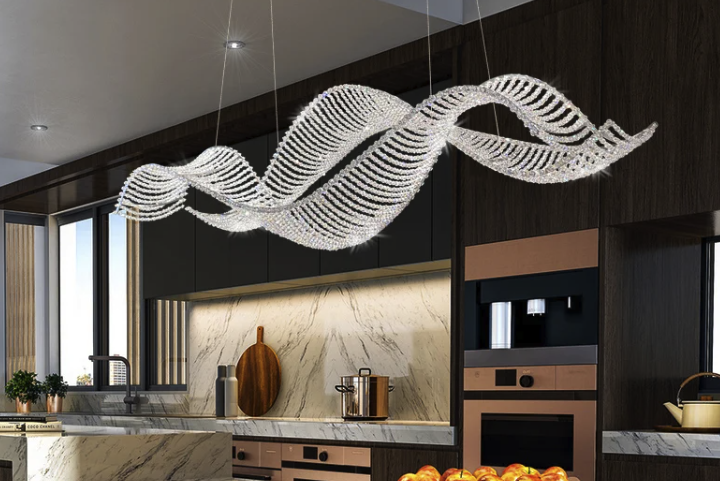
Retro Revival: LED Wave Chandelier for Artful Dining
In recent years, there has been a notable resurgence in the popularity of retro design elements across various aspects of interior decor. This revival is not merely a fleeting trend; it reflects a deeper cultural yearning for nostalgia and a desire to reconnect with the aesthetics of past decades. From the bold colors and geometric patterns of the 1960s to the sleek lines and minimalist forms of the 1980s, retro design encapsulates a rich tapestry of styles that resonate with both older generations and younger audiences alike.
The rise of social media platforms, particularly Instagram and Pinterest, has played a pivotal role in this revival, allowing individuals to share their vintage finds and inspire others to embrace retro aesthetics in their own homes. The retro revival is also evident in the dining space, where vintage-inspired furniture and decor are making a significant comeback. Dining rooms are increasingly being transformed into vibrant spaces that reflect personal style while paying homage to the past.
This trend is characterized by the use of classic materials such as wood and metal, combined with modern touches that create a harmonious blend of old and new. As people seek to create inviting environments for gatherings and meals, the retro revival serves as a reminder of the charm and warmth that can be found in designs from yesteryears.
The Artful Dining Experience
Dining is no longer just about sustenance; it has evolved into an artful experience that engages all the senses. The ambiance of a dining space plays a crucial role in shaping this experience, influencing everything from the mood of the meal to the interactions among diners. Thoughtfully designed dining areas can elevate an ordinary meal into a memorable occasion, where the aesthetics of the space complement the culinary delights being served.
Elements such as color schemes, furniture choices, and lighting all contribute to creating an atmosphere that encourages conversation and connection. Incorporating artful elements into dining spaces can take many forms, from unique table settings to curated wall art. The choice of tableware, for instance, can reflect personal style while enhancing the overall aesthetic.
Vintage plates, handcrafted ceramics, or even bold, modern designs can serve as conversation starters. Additionally, wall art that resonates with the theme of the dining area can create a cohesive look that draws guests in. The careful selection of these elements transforms dining into an immersive experience, where every detail is considered to enhance enjoyment and foster a sense of belonging.
LED Wave Chandelier: A Modern Twist on a Classic Design
Among the myriad of lighting options available today, the LED Wave Chandelier stands out as a striking example of how modern technology can breathe new life into classic design concepts. This chandelier combines the elegance of traditional chandeliers with contemporary LED technology, resulting in a stunning visual centerpiece that captures attention without overwhelming the space. The wave-like design mimics natural forms, evoking a sense of fluidity and movement that can transform any dining area into a dynamic environment.
The LED Wave Chandelier is not only aesthetically pleasing but also highly functional. With adjustable brightness settings and energy-efficient LED bulbs, it allows for customization based on the time of day or occasion. Whether hosting an intimate dinner party or enjoying a casual family meal, this chandelier can adapt to create the perfect ambiance.
Its versatility makes it an ideal choice for those looking to make a statement while also prioritizing practicality in their lighting solutions.
The Impact of LED Technology on Lighting Design
The advent of LED technology has revolutionized lighting design across various sectors, including residential spaces. Unlike traditional incandescent bulbs, LEDs offer numerous advantages such as energy efficiency, longevity, and reduced heat output. This shift has prompted designers to explore innovative ways to incorporate LED lighting into their creations, leading to more creative and sustainable designs.
The ability to produce a wide range of colors and intensities has opened up new possibilities for mood-setting and artistic expression in lighting. Moreover, LED technology has enabled designers to experiment with form and function in ways that were previously unattainable. For instance, the slim profile of LED fixtures allows for sleek designs that can seamlessly integrate into any decor style.
Additionally, advancements in smart lighting technology have further enhanced the capabilities of LED systems, allowing users to control their lighting through mobile apps or voice commands. This level of customization empowers homeowners to curate their environments according to their preferences, making lighting an integral part of interior design rather than an afterthought.
Creating a Statement Piece for Your Dining Space
A statement piece in a dining area can serve as the focal point that ties together various design elements while showcasing personal style. The right piece not only enhances the aesthetic appeal but also sparks conversation among guests. When selecting a statement piece, it is essential to consider scale, color, and material to ensure it complements the overall design scheme.
For instance, an oversized artwork or an intricately designed chandelier can draw attention and set the tone for the entire room. Incorporating unique materials can also elevate a statement piece from ordinary to extraordinary. For example, a dining table made from reclaimed wood can add character and warmth while telling a story about its past life.
Similarly, a sculptural centerpiece crafted from metal or glass can introduce an element of modernity that contrasts beautifully with more traditional furnishings. By thoughtfully curating these elements, homeowners can create a dining space that reflects their individuality while providing an inviting atmosphere for gatherings.
The Versatility of the LED Wave Chandelier
The versatility of the LED Wave Chandelier Zouille makes it an exceptional choice for various dining environments. Its design allows it to seamlessly transition between different styles, from contemporary to eclectic or even rustic settings. This adaptability means that homeowners do not need to compromise on aesthetics when choosing lighting; instead, they can select fixtures that enhance their existing decor while providing modern functionality.
Furthermore, the LED Wave Chandelier can be used in various settings beyond just dining rooms. Its elegant form makes it suitable for kitchens, entryways, or even living areas where ambient lighting is desired. The ability to adjust brightness levels means it can serve different purposes throughout the day—brightening up a space during meal prep or creating a soft glow for evening gatherings.
This multifunctionality ensures that investing in such a chandelier is not only about aesthetics but also about enhancing everyday living experiences.
Incorporating Retro Elements into Modern Interior Design
Integrating retro elements into modern interior design allows homeowners to create spaces that are both nostalgic and contemporary. This fusion can be achieved through various means, such as selecting vintage furniture pieces or incorporating retro-inspired decor items like patterned textiles or bold wallpaper designs reminiscent of past eras. By carefully curating these elements, individuals can evoke a sense of history while maintaining a fresh and updated look.
Color plays a significant role in this integration process as well. Retro palettes often feature vibrant hues that can be reimagined in modern contexts through accent walls or decorative accessories. For instance, pairing mustard yellow with sleek white cabinetry can create a striking contrast that feels both nostalgic and current.
Additionally, incorporating retro lighting fixtures like pendant lamps or wall sconces alongside modern furnishings can create visual interest and depth within a space.
Tips for Choosing the Right Lighting for Your Dining Area
Selecting the right lighting for a dining area involves considering several factors that contribute to both functionality and aesthetics. First and foremost, it is essential to assess the size and layout of the space. A larger dining table may require multiple light sources or an oversized chandelier to ensure adequate illumination without creating harsh shadows.
Conversely, smaller spaces may benefit from more intimate lighting options that foster warmth and coziness. Another critical aspect is understanding the desired ambiance for different occasions. Dimming capabilities are invaluable in achieving this flexibility; they allow homeowners to adjust lighting levels based on whether they are hosting formal dinners or casual gatherings.
Additionally, layering different types of lighting—such as ambient, task, and accent—can enhance the overall experience by providing both general illumination and focused light where needed. By thoughtfully considering these elements, individuals can create dining spaces that are not only visually appealing but also functional for everyday use and special occasions alike.

